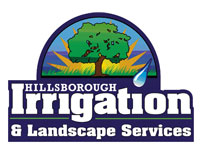
Keeping Your Property Well-Drained
Have you ever noticed large puddles of water around your property after a strong storm hits? If you have, this means that your landscape was not designed with a good drainage system. When excess stormwater is unable to move it builds up in your yard, and this can create serious damage over time. If you have some time, take a few minutes to read about why good drainage is so important, and see how you can implement a landscape drainage solution.
How do Drainage Issues Occur?

An influx of rainwater caused by a powerful storm is not the only thing that creates drainage problems. If you installed downspout storm drains right along the foundation of your house, this can also cause problems. Downspout drains are supposed to transport water away from your house, but if they are installed too close to the building’s foundation they could redirect water right next to your house.
Adding to the problems is the fact that leftover stormwater can take a long time to move. Water tends to flow towards lower locations, so if there is a noticeably low spot in your yard stormwater will get trapped there. Without an effective way to remove this water, it will stay there until it is eventually evaporated. Until that happens, this standing water can cause a lot of problems.
Damage Caused by Drainage Solutions

Source: mecklenburg on Flickr
Rainwater that is not able to move can cause serious harm to your property in a number of ways. Large, unmoving puddles of water crush the grass underneath it, and if the water stays for too long the grass could start to die. As mentioned previously, overflowing water could be directed towards your house, and this can result in either a flooded basement, the development of mold on the walls, or damage to the building’s foundation.
In addition, standing water can also cause problems during the summer, particularly ones that involve mosquitos. These insects love to breed in open areas of water, and if you let puddles of standing water sit around for too long a mosquito infestation could occur. Finally, if your yard ends up flooding you cannot use it until the water clears out, and this can ruin your day when the weather is nice.
What Does a Drainage Solution Do?
Typically, one of the best ways to combat drainage problems is to install a drainage solution in your yard. Drainage solutions are designed to transport built-up water away from your property. By moving stationary water away from your home, the drainage solution protects the things in your yard from major water damage.
Depending on the setup of your yard, the installation of a drainage solution can take about a day or two. Typically, you should consider installing one of these solutions during the summer, since the drier soil is easier to dig up. Doing this will also protect your yard from the powerful storms that occasionally occur during the summer.
Types of Drainage Solutions

Source: Wikimedia Commons
One of the most common drains you can install in your yard is the French drain, also known as the trench drain. To construct this solution, a small trench is dug in your yard, since water typically diverts to lower areas during a storm. Inside the drain, perforated pipes with holes on top will be installed. Water that enters the trench will go into the pipe, and the pipe system will transport the water away from your property.
A somewhat easier drainage solution to install is the permeable paver. This unique method of paving involves creating patios and walkways that have open spaces. When rain falls, the open spaces in the pavement help redirect the water back into the soil, helping to keep your lawn healthy. Hillsborough Irrigation offers a wide selection of drainage solutions that you can install in your yard, so call us today if you want to do an installation.
Would you like to request a free estimate for our drainage solutions?

